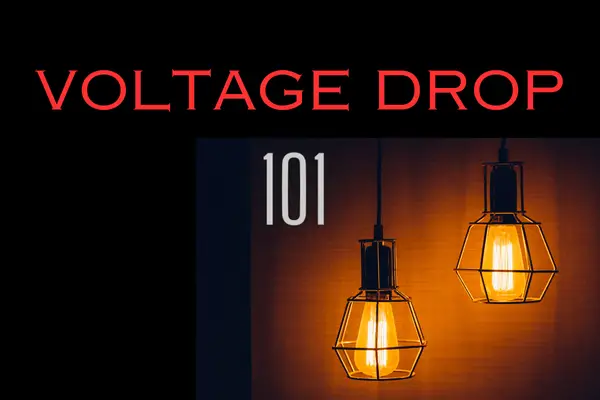Electrical systems power our homes, offices, and industries, making them an integral part of our daily lives.
One crucial aspect often overlooked is voltage drop, a phenomenon that can affect the performance and safety of our electrical devices.
This guide explores what voltage drop is, why it matters, how to calculate it, and practical ways to prevent and mitigate its effects.
What is Voltage Drop?
Voltage drop occurs when there is a reduction in electrical potential along a conductor. Several factors contribute to this phenomenon, including resistance in conductors, the length of the wiring, the flow of current, and temperature. Think of it as energy loss as electricity travels from the power source to your devices.
Why Voltage Drop Matters
Voltage drop isn’t just an abstract electrical concept; it directly impacts the performance and safety of our appliances and electronics.
As electrical current encounters resistance in wiring, devices may receive less voltage than they need, leading to inefficiencies and potential damage.
Moreover, understanding voltage drop is crucial for adhering to safety standards outlined in the National Electrical Code (NEC) to prevent fire hazards.
what causes the voltage to drop?
Voltage drop occurs primarily due to the inherent resistance in conductors and other elements of an electrical circuit. Several factors contribute to voltage drop:
- Resistance in Conductors: Every conductor, such as wires and cables, has some level of resistance to the flow of electric current. As electrons move through the conductor, they encounter resistance, leading to a drop in voltage.
- Length of Conductors: Longer conductors offer more pathways for electrons to encounter resistance. Consequently, the longer the wire or cable, the higher the voltage drop.
- Current Flow: Higher current intensities result in increased voltage drop. This is due to the elevated level of electron movement encountering greater resistance within the conductor.
- Temperature: The temperature of conductors affects their resistance. As temperatures rise, so does resistance, leading to a higher likelihood of voltage drop. This is particularly relevant in situations where conductors are exposed to heat or when there is high current flow.
Understanding these factors is crucial for maintaining electrical efficiency and safety in various applications, from residential wiring to industrial installations.
Engineers and electricians carefully consider these factors during the design and installation of electrical systems to minimize voltage drop and ensure reliable performance.
Voltage Drop Prevention and Mitigation
Preventing voltage drop involves making informed choices during the electrical installation process. Proper wire sizing, shortening cable lengths, minimizing current flow, and using high-conductivity materials are key strategies.
- Proper Wire Sizing:
- Explanation: The size or gauge of a wire determines its electrical conductivity. In electrical systems, using wires with an adequate gauge for the specific application reduces resistance. Lower resistance means less voltage drop.
- Example: When wiring a home, selecting the right gauge for different circuits ensures that the wires can handle the current without significant voltage loss.
- Shortening Cable Lengths:
- Explanation: As mentioned earlier, longer conductors contribute to increased resistance and, consequently, voltage drop. By minimizing the length of cables and wires between the power source and the destination (appliance or device), you reduce the overall resistance in the circuit.
- Example: In industrial settings, where long cable runs may be necessary, strategically placing power sources closer to the equipment can help minimize voltage drop.
- Minimizing Current Flow:
- Explanation: Voltage drop is directly proportional to the current flowing through a conductor. By optimizing the design and layout of electrical circuits, you can minimize the current flow, subsequently reducing voltage drop.
- Example: In a residential setting, distributing power outlets strategically and avoiding overloading circuits can help balance the current flow and prevent excessive voltage drop.
- Using High-Conductivity Materials:
- Explanation: Some materials conduct electricity more efficiently than others. Choosing high-conductivity materials, such as copper instead of aluminum for wiring, can help minimize resistance and voltage drop.
- Example: In commercial construction, where large-scale electrical systems are common, opting for high-quality, conductive materials ensures optimal performance and minimizes voltage drop.
Implementing these strategies requires careful consideration during the design and installation phases of electrical systems.
Electricians and engineers assess factors such as the distance between power sources and devices, the expected current load, and the properties of the conductive materials to make informed choices that mitigate voltage drop and promote efficient electrical operation.
Voltage Drop Woes? Here’s How to Choose the Perfect Wire Size
Conclusion
In conclusion, understanding voltage drop is essential for anyone interacting with electrical systems. By being aware of its causes, effects, and preventive measures, you can ensure your devices operate optimally and safely.
As we move towards a future with smarter and more efficient electrical solutions, the knowledge gained from this guide will remain invaluable in maintaining a reliable power supply for our ever-evolving technological needs.
Want to learn more about electricity? Check my YouTube channel!
Are You An Electrical Engineer or Electrician?
Install my Free On Google Play Now! It’s 100% Free
The staff I recommend (Amazon Affiliate Links to products I believe are high quality):
- Economy 120 Volt/60Hz AC Power Source – Step-Down Voltage & Frequency Converters 1800W
- UNI-T Digital Multimeter Tester UT139C
- 50-Amp Extension Cord for RV “100ft”
- Voltage Stabilizer 110/220v
- Hair Dryer “best selling“
- TOSHIBA EM131A5C-BS Countertop Microwave Ovens
Disclaimer: This contains affiliate links to Amazon products. I may earn a commission for purchases made through these links.

